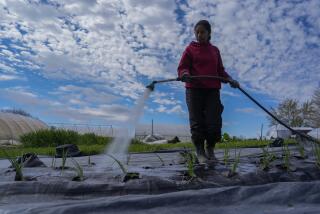U.S. drought pushing corn prices toward record highs
- Share via
The nation’s punishing drought is pushing corn prices to record levels as the government predicted Friday that this season’s yield will fall 15.5% to its lowest since 1995.
In cutting its estimate for the corn crop, theU.S. Department of Agricultureraised the upper end of its price forecast by 39% to $8.90 a bushel. In early June, corn futures were selling at just over $5 a bushel.
The U.S. is the world’s largest producer of corn, but harsh weather conditions in Europe and Brazil also are reducing the global supply of grains such as corn, a key ingredient in processed foods, animal feed and ethanol fuel.
“Corn is the single most important commodity for retail food,” said Richard Volpe, an economist for the USDA. “Corn is either directly or indirectly in about three-quarters of all food consumers buy.”
Consumers aren’t likely to see the higher prices on store shelves until this fall or early next year.
This year was supposed to be a stellar one for corn farmers as they planted the most acreage in decades. But with a few weeks left before harvest, the USDA this week found that half the nation’s corn crop is in “poor” to “very poor” condition.
Corn futures — contracts for commodities to be delivered later — hit a record of $8.49 a bushel in early trading Friday, but closed at $8.01, on the Chicago Mercantile Exchange.
“Some analysts had presumed it’d be better. It is probably now quite certain that the type of prices we’ll have to live with are not going to be like anything we had anticipated at the start of the season,” said Abdolreza Abbassian, senior economist for the United Nations Food and Agriculture Organization.
Friday’s USDA report didn’t come as a surprise. The agency had been downgrading the corn crop condition week after week as the drought extended and widened its grip on the country’s midsection.
Compounding domestic fears over surging prices, the U.N. organization this week reported a 6% jump in its international food price index for July from the previous month.
The group, which tracks price changes in foods like dairy, meat and oils and fats, reported the largest monthly jump — 17% — in its cereal price index, almost reaching its previous high of 274 points in April 2008. It attributed that increase largely to the faltering U.S. corn production.
Tom Vilsack, the U.S. secretary of Agriculture, tried to assuage fears over the drought’s effect.
“The productivity and resilience of American farmers and ranchers allow the United States to be the most reliable supplier of food and agricultural products in the world,” Vilsack told the Associated Press. “We will continue to meet all of those demands and Americans shouldn’t see immediate increases in food prices due to the drought.”
In its report, the USDA forecast the nation’s corn yield to be about 123.4 bushels an acre, down from its July projection of 146 bushels an acre. Corn production for 2012-13 also was expected to drop to its lowest levels in six years to 10.8 billion bushels.
The department also forecast the country’s soybean crop at 2.7 billion bushels, down 358 million from the last month’s estimate. Supplies of soybeans, another key ingredient in processed foods and animal feed, are now projected to fall to a nine-year low.
To cope with rising corn prices, purchasers bought in bulk when prices were lower, said Larry Shover, chief investment officer for SFG Alternatives, a consulting group in Lincolnshire, Ill.
Still, he said, the price of poultry, for instance, is likely to rise 7 to 10 cents a pound. And the price of processed foods containing corn should rise as well, though he couldn’t predict by how much.
Tyson Foods Inc., one of the world’s largest meat producers, said it expected that its third-quarter earnings would be affected by higher feed costs and softer consumer demand.
In California, livestock farmers will be hurting not only from higher feed costs but also from shipping costs because they buy nearly all their feed from the Midwest. “For consumers in California, it means livestock products will be a bit more expensive, milk and eggs especially because they are a bit more tied to grain production,” said Daniel Sumner, a UC Davis agriculture economist.
The USDA’s consumer price index released last month forecast the price of beef to rise as much as 5% next year. Dairy products are expected to rise by 4.5%, and poultry by 4%.
The department releases its next estimate on food prices on Aug. 24.
william.d’urso@latimes.com
More to Read
Inside the business of entertainment
The Wide Shot brings you news, analysis and insights on everything from streaming wars to production — and what it all means for the future.
You may occasionally receive promotional content from the Los Angeles Times.











